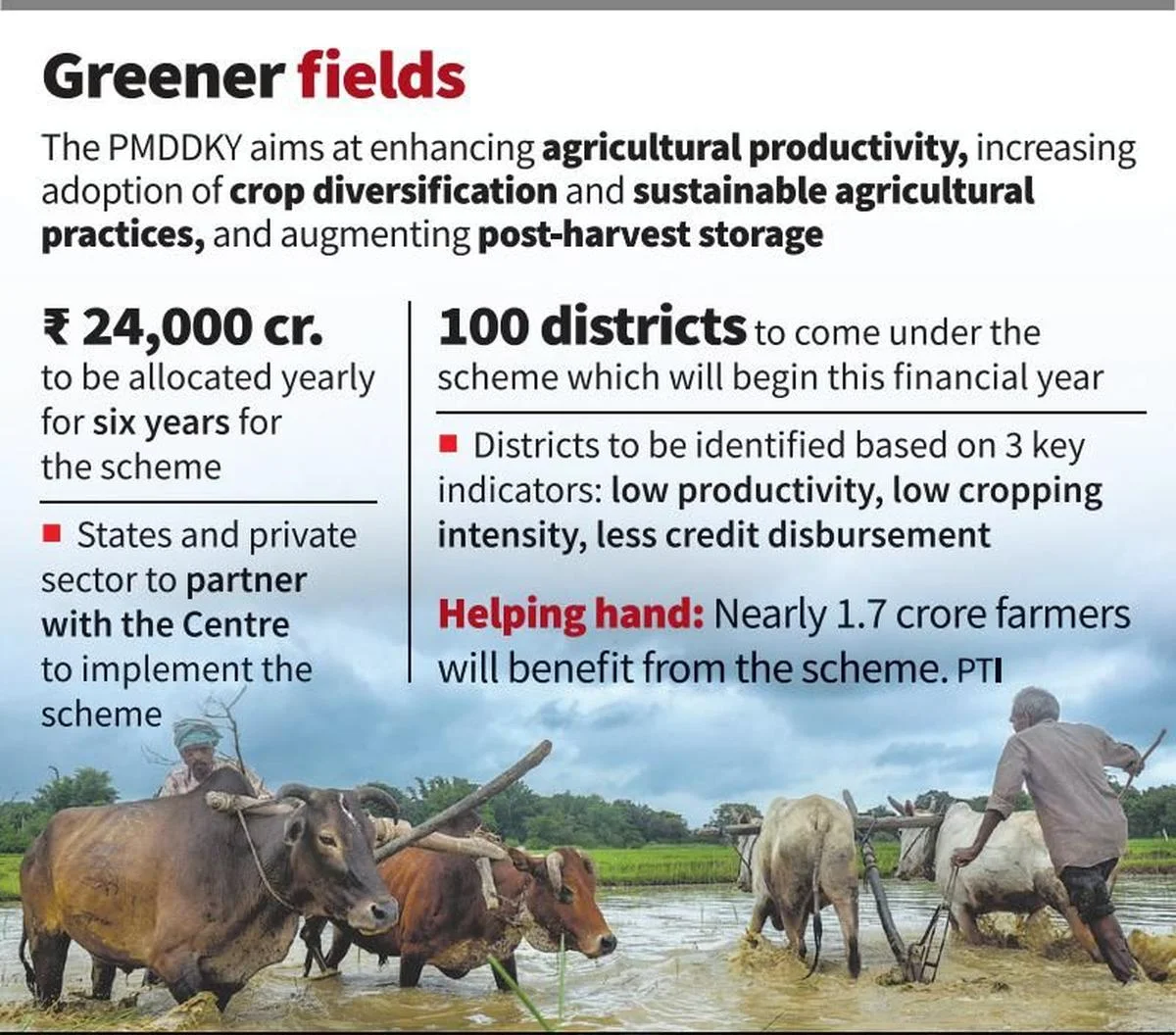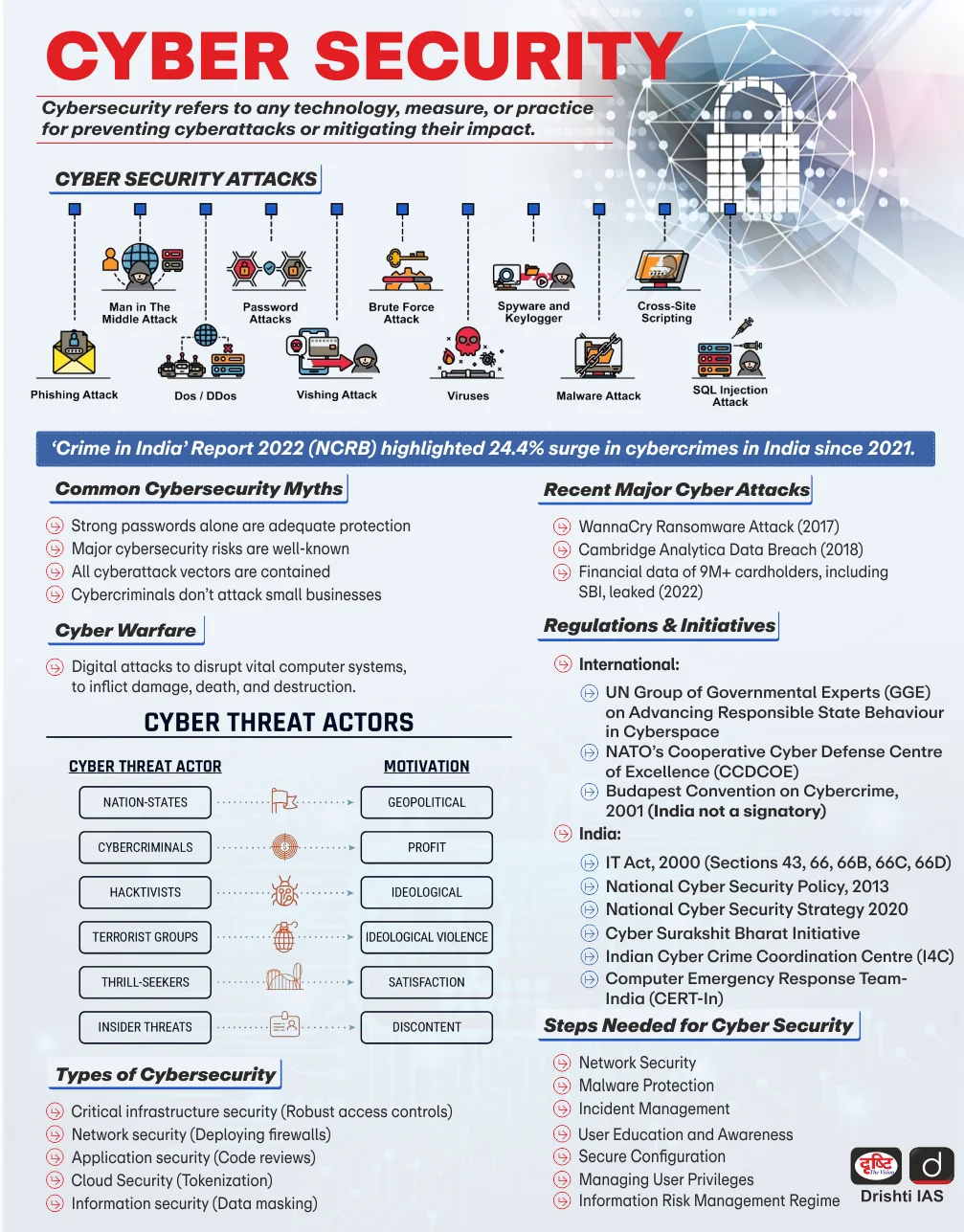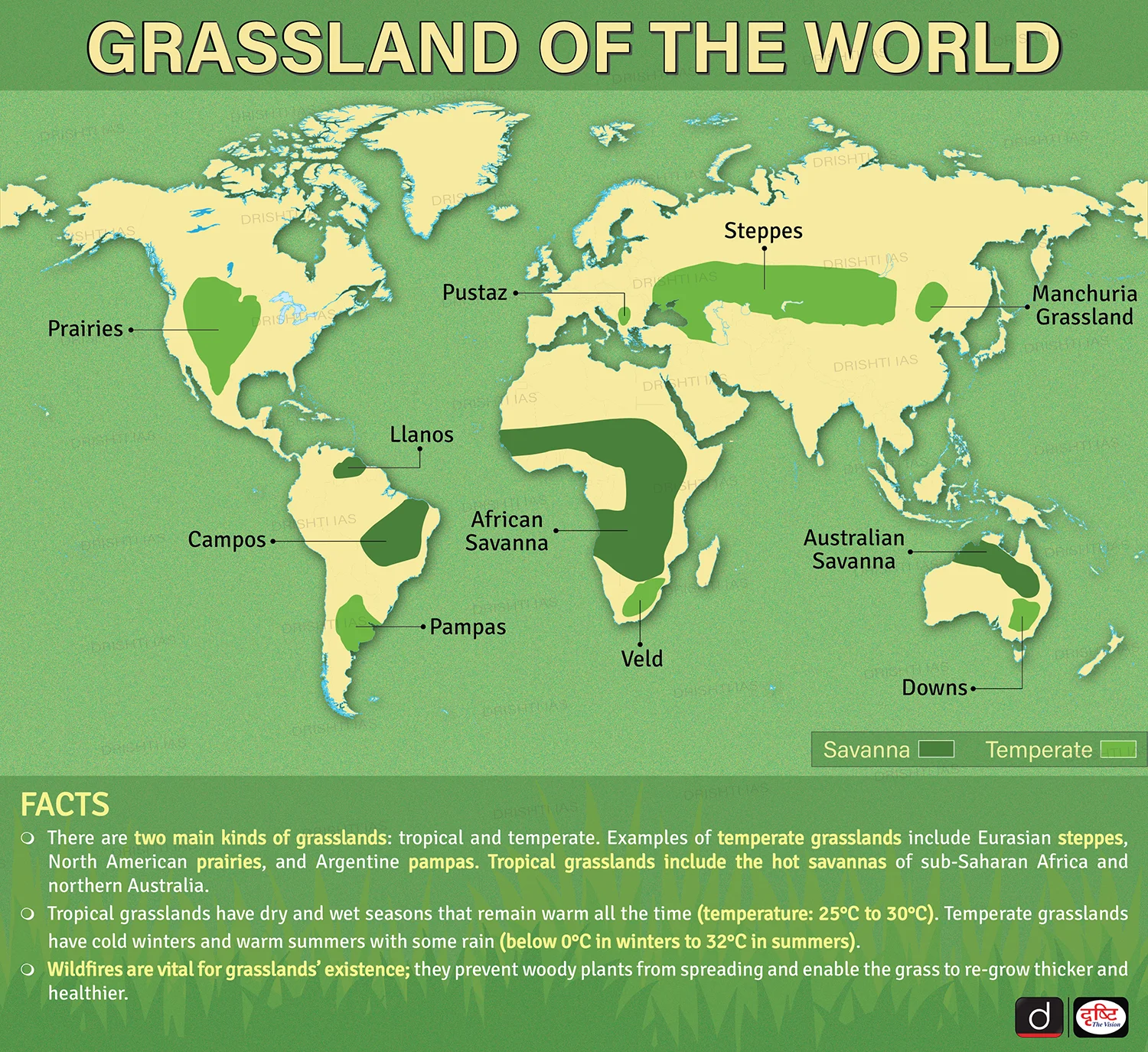Governance
PM Dhan-Dhaanya Krishi Yojana
For Prelims: Union Budget 2025–26, Aspirational Districts Programme, Minimum Support Price, Agricultural Infrastructure Fund
For Mains: Government schemes for agricultural development, Data-driven governance in rural transformation, Agricultural infrastructure and value chain development
Why in News?
The Union Cabinet has approved the Prime Minister Dhan-Dhaanya Krishi Yojana (PMDDKY), a major initiative aimed at transforming Indian agriculture. Originally announced in the Union Budget 2025–26, the scheme has an annual outlay of Rs 24,000 crore for six years, starting from 2025–26.
- PMDDKY, inspired by NITI Aayog’s Aspirational Districts Programme, targets 100 underperforming districts to boost farm productivity through improved irrigation, storage, credit access, and sustainable practices.
What is the PM Dhan-Dhaanya Krishi Yojana?
- About: PMDDKY is a comprehensive farm programme designed to enhance productivity, promote sustainable practices, and improve livelihoods.
- It merges 36 schemes from 11 Union Ministries to create a unified agricultural support system.
- District Selection Criteria:
- Low Productivity: Districts with low agricultural output per hectare.
- Low Cropping Intensity: Regions with limited crop variety or insufficient crop cycles per year.
- Low Credit Disbursement: Areas with limited access to financial resources for farmers.
- Representation Across States: The selection will consider the share of Net Cropped Area and operational holdings in each state/union territory.
- A minimum of one district will be selected from each state to ensure balanced regional development.
- Implementation and Monitoring:
- District Agriculture and Allied Activities Plans: Each district will prepare a plan through the District Dhan Dhaanya Samiti, involving progressive farmers, aligned with national goals like crop diversification, water conservation, and agricultural self-sufficiency.
- Monitoring and Evaluation: Progress will be tracked through 117 Key Performance Indicators (KPIs) using a dedicated dashboard, with monthly reviews.
- Central Nodal Officers will be appointed for each district to ensure smooth implementation. NITI Aayog will guide and review district plans regularly.
- Committees at Various Levels: Committees at the district, state, and national levels will oversee planning, implementation, and progress monitoring to ensure the scheme’s effectiveness.
- Expected Outcomes: 1.7 crore farmers across India are expected to benefit directly.
- The scheme integrates allied sectors like livestock, dairy, and fisheries to add value and create local livelihoods. It focuses on post-harvest storage, improved irrigation, easier credit access, and promotes natural and organic farming, enhancing rural economic resilience.
Aspirational Districts Programme (ADP)
- Launch: Initiated in 2018 by the Government of India to uplift 112 of the most underdeveloped districts.
- Focus Areas: Health, nutrition, education, infrastructure, and economic opportunities.
- Key Principles and Approach:
- 3Cs Framework:
- Convergence: Coordination between various central and state schemes.
- Collaboration: Involvement of district, state, and national agencies.
- Competition: Healthy competition among districts to drive development.
- Data-Driven Governance: Progress is tracked using a public platform, the Champions of Change Dashboard, which monitors 49 indicators across five areas.
- 3Cs Framework:
- Monitoring: The Champions of Change Dashboard monitors progress across 49 indicators, focusing on real-world issues such as infant mortality, school dropout rates, sanitation, and crop productivity.
- Unlike traditional rankings, ADP employs the delta ranking system that measures the pace of progress, motivating districts to compete against their own past performances.
- Success Stories:
- Chamba, Himachal Pradesh: Once a symbol of rural deprivation. In February 2022, it became the 100th district to achieve “Har Ghar Jal” status, providing every household with clean tap water.
- The district also saw 100% coverage under Pradhan Mantri Jan Dhan Yojana (PMJDY), ensuring financial inclusion.
- Notable District Successes: By 2019, 8 districts moved from Tier IV to Tier I showcasing significant improvement in agriculture, health, and infrastructure.
- Andhra Pradesh stood out, with 2 of its 3 Aspirational Districts ranking in the top 10, showing strong sectoral progress.
- Chamba, Himachal Pradesh: Once a symbol of rural deprivation. In February 2022, it became the 100th district to achieve “Har Ghar Jal” status, providing every household with clean tap water.
- Global Recognition of ADP: Singapore’s highlighted ADP as a "globally relevant model" for empowering communities and strengthening local health systems.
- The ADP’s emphasis on localized, inclusive governance has been recognized as a model that can be replicated in other developing countries.
What are India's Initiatives Promoting Agricultural Productivity in India?
- Increased Budget Allocation for Agriculture: The sharp rise in the agriculture budget from Rs 11,915 crore in 2008-09 to Rs 1,22,528 crore in 2024-25 has enabled greater investment in inputs, research, irrigation, and infrastructure, all of which contribute to higher productivity.
- Agricultural Infrastructure Fund (AIF) launched in 2020, has supported over 87,500 projects, boosting post-harvest infrastructure such as warehouses and cold chains. This has helped reduce crop losses and encouraged the cultivation of high-value crops.
- Crop Yield Improvements: Between 2013-14 and 2023-24, yields for key crops like rice, wheat, maize, and pulses saw notable increases.
- For instance, crop yields rose with rice (19.3%), wheat (13.2%), maize (25.2%) and coarse cereals (71.5%).
- Minimum Support Price (MSP) Enhancements: MSP revisions, ensuring at least 50% profit over the cost of production, have encouraged farmers to invest more in inputs and better crop management, indirectly supporting productivity.
- e-NAM Integration and Market Access: Better price discovery through electronic National Agriculture Market (e-NAM) (1,410 mandis linked) has incentivized farmers to adopt higher-yield crops and improve quality.
- Pradhan Mantri Fasal Bima Yojana (PMFBY): Crop insurance under PMFBY encourages risk-taking and adoption of modern practices. Farmers are more likely to invest in better technologies if crop failure risks are covered.
- Soil Health Cards: Over 25 crore Soil Health Cards have been distributed, helping farmers use the right fertilisers and improve crop yields while reducing harmful chemical use.
- Fertiliser Subsidies: For 2025–26, the government allocated over Rs 1.67 lakh crore for fertiliser subsidies, making up nearly 70% of the agriculture budget and 40% of total subsidy spending.
- Institutional Credit Expansion & Kisan Credit Card (KCC): The growth in short-term agri credit from Rs 6.4 lakh crore (2014-15) to Rs 15.07 lakh crore (2023-24) has given farmers better access to inputs like fertilizers, quality seeds, and machinery, all of which support productivity.
- As of 2024, there are 7.75 crore active KCC accounts with ₹9.81 lakh crore in loans.
|
Drishti Mains Question: Discuss how the Prime Minister Dhan-Dhaanya Krishi Yojana aims to transform agriculture in underperforming districts. |
UPSC Civil Services Examination, Previous Year Question (PYQ)
Mains
Q. Explain various types of revolutions, took place in Agriculture after Independence in India. How have these revolutions helped in poverty alleviation and food security in India? (2017)
Q. Given the vulnerability of Indian agriculture to vagaries of nature, discuss the need for crop insurance and bring out the salient features of the Pradhan Mantri Fasal Bima Yojana (PMFBY). (2016)


Internal Security
Rising Cyber Frauds in India
For Prelims: Cybercrime, Digital arrest, Information Technology Act, Digital Personal Data Protection Act, Indian Computer Emergency Response Team, National Critical Information Infrastructure Protection Centre, Cyber Swachhta Kendra, Ransomware attack, Budapest Convention on Cybercrime.
For Mains: Current Framework for Cyber Security in India, Key Emerging Cyber Threats Affecting India's Digital Landscape.
Why in News?
The Indian Cyber Crime Coordination Centre (I4C), a unit under the Ministry of Home Affairs (MHA), has reported a sharp surge in financial cyber frauds targeting Indian citizens, primarily originating from Southeast Asian countries.
What is the State of Financial Cyber Frauds in India as per I4C Analysis?
- Rising Financial Losses: In the first half of 2025, India lost an average of Rs 1,000 crore per month to cyber frauds, totaling Rs 7,000 crore.
- According to the I4C,the projected annual loss may exceed Rs 1.2 lakh crore (Rs 1.2 trillion) in 2025, amounting to 0.7% of India’s GDP.
- Origin & Nature of Scams: Over 50% of cyber frauds targeting Indians originated from Southeast Asian countries such as Cambodia, Myanmar, Vietnam, Laos, and Thailand, operated from high-security compounds allegedly run by Chinese handlers.
- These primarily involve stock trading/investment scams, digital arrest scams & task-based and investment-based scams.
- Indian intelligence has identified 45 scam centres in Cambodia, 5 in Laos, and 1 in Myanmar.
- Modus Operandi: Victims, including Indians, are being trafficked via fake job offers and routed through countries like Dubai, China, and Thailand to operate cyber scams.
- Recruitment agents are active across Indian states (Maharashtra, Tamil Nadu, J&K, Uttar Pradesh, and Delhi).
- Systemic Gaps & Enforcement Action: India’s cyber fraud ecosystem is exploited due to loopholes in digital banking transactions, issuance of ghost SIM cards by PoS agents in the telecom sector, and weak verification processes in immigration, enabling anonymous and cross-border cybercrimes.
Indian Cyber Crime Coordination Centre (I4C)
- About: The Indian Cyber Crime Coordination Centre (I4C) was launched by the Ministry of Home Affairs in 2020 to provide a comprehensive and coordinated response to cybercrime, including financial frauds.
- Key Objectives:
- Act as the national nodal agency to monitor, prevent, and investigate cybercrimes, especially those targeting women, children, and critical infrastructure.
- Provide an early warning system and facilitate trend analysis, pattern recognition, and data sharing among law enforcement agencies.
- Enable easy reporting of cybercrime and promote public awareness on cyber hygiene and fraud prevention.
- Assist States/UTs in building capacity of police, prosecutors, and judicial officers in areas like cyber forensics and investigation.
- National Cyber Crime Reporting Portal: A citizen-centric platform under I4C that enables individuals to report cyber frauds online. Reported complaints are forwarded to the relevant law enforcement agencies for necessary legal action.
What are Cyber Frauds?
- About: Cyber frauds are criminal activities conducted using digital technology (internet) to deceive individuals or organizations for financial gain.
- It exploits vulnerabilities in cybersecurity systems, digital platforms, or human behavior to steal money, data, or identities.
- Types of Cyberfrauds:
|
Cyber Fraud/ Threats |
Description |
|
Digital Arrests |
Impersonating authorities (police or income tax officers) to extort money. |
|
Online Job/Task-Based Scams |
Fake work-from-home offers with upfront payments. |
|
Malware |
Malware is used to steal personal information that allows cyber criminals to gain control of a victim's computer. |
|
Ransomware |
Ransomware encrypts a victim's files and demands payment for decryption. E.g., WannaCry attack in 2016 |
|
Phishing |
Phishing involves emails that appear to be from trusted sources, tricking users into clicking links that lead to fake websites and attackers gaining sensitive details e.g., credit card numbers. |
|
Cyberbullying |
Cyberbullying includes any threat to a person’s safety, coercion to say or do anything. |
|
Cyber Spying |
Cyber Spying targets a public or private entity’s network to gain access to classified data, private information, or intellectual property. |
|
Business Email Compromise (BEC) |
Scammers hack legitimate email accounts to impersonate suppliers, employees, or tax office members, considered a white-collar crime. |
|
Dating Hoodwinks |
Hackers use dating websites, chat rooms, and online dating apps to pose as potential partners and gain access to personal data. |
|
ATM/PoS Frauds |
Skimming card details or unauthorized transactions. |
- Consequences of Cyber Fraud:
- Individuals face unauthorised financial transactions, loss of account access, and misuse of personal data for harassment or blackmail.
- Businesses risk legal penalties, regulatory fines, and loss of market value due to compromised client data.
- Governments face threats to national security as cyber breaches target defence and critical information systems.
- Notable Cyberfraud Incidents:
- Aadhaar Data Breach (2018): Personal data of 1.1 billion Aadhaar cardholders was compromised, including Aadhar numbers, PAN and bank details.
- Canara Bank ATM Attack (2018): Hackers used skimming devices on 300 debit cards, leading to a theft of over Rs 20 lakh.
- Pegasus Spyware Case: The Israeli spyware Pegasus was allegedly used to access data from mobile devices without consent, affecting over 300 verified Indian phone numbers.
What are the Key Emerging Cyber Threats Affecting India's Digital Landscape?Click Here to Read: Emerging Cyber Threats in India |
What are the Key Initiatives Related to Cybersecurity?
- Global Initiatives on Cybersecurity:
- Budapest Convention on Cybercrime: It is the first international treaty to address cybercrime through legal harmonization, investigative cooperation, and capacity building. It came into force on 1st July 2004.
- India is not a signatory of the Budapest Convention.
- Internet Governance Forum (IGF): IGF is a multi-stakeholder platform under the UN that facilitates dialogue among governments, private sector, academia, and civil society on public policy issues related to Internet governance and cybersecurity.
- UNGA Resolutions on ICT Security: The United Nations General Assembly (UNGA) has established 2 key platforms for addressing cybersecurity:
- Open-ended Working Group (OEWG), initiated by Russia, focuses on inclusive dialogue and capacity building in ICT security.
- Group of Governmental Experts (GGE), initiated by the USA, works on developing norms of responsible state behaviour in cyberspace and international legal frameworks.
- Budapest Convention on Cybercrime: It is the first international treaty to address cybercrime through legal harmonization, investigative cooperation, and capacity building. It came into force on 1st July 2004.
- Indian Initiatives:
- Legislative Measures:
- Institutional Framework:
- Indian Computer Emergency Response Team (CERT-In)
- National Critical Information Infrastructure Protection Centre (NCIIPC)
- Indian Cyber Crime Coordination Centre (I4C)
- Cyber Swachhta Kendra
- Citizen Financial Cyber Fraud Reporting and Management System for real-time monitoring, tracking, and resolution of cyber fraud cases.
- The Central Bureau of Investigation (CBI) registered FIRs against PoS agents for issuing fraudulent SIMs.
- Strategic Initiatives:
- Bharat National Cybersecurity Exercise 2024
- National Cyber Security Policy, 2013: Provides vision and strategies for securing cyberspace and protecting critical information infrastructure.
- Chakshu & Digital Intelligence Platform by DoT:
- Chakshu, a tool on Sanchar Saathi portal to report fraudulent calls, SMS, or WhatsApp messages related to KYC expiry or bank account updates.
- Digital Intelligence Platform to enable real-time coordination to tackle cyber frauds.
- Sector-Specific Regulations:
- Cybersecurity Framework for SEBI Regulated Entities: Mandates cybersecurity policies for securities markets.
- Telecommunications (Critical Telecommunication Infrastructure) Rules, 2024
What Measures Should be Taken to Strengthen Cybersecurity Frameworks in India?
- Infrastructure & AI-Based Security: Strengthen digital infrastructure through firewalls, regular software/hardware updates, and AI-driven threat detection systems to proactively identify, predict, and neutralize cyber threats.
- AI tools must support ransomware prediction, incident response, and forensic analysis.
- Cyber Awareness & Literacy: Launch nationwide cyber literacy programs in regional languages targeting rural communities, youth, and senior citizens.
- Incorporate cybersecurity education in schools and universities to build digital resilience from an early age, supported by secure infrastructure and staff training.
- Institutional & Audit Reforms: Conduct mandatory cybersecurity audits in critical sectors like banking, healthcare, and utilities, including stress tests and employee preparedness.
- Establish district-level cybersecurity units for localized threat management and coordination with CERT-In.
- Corporate & Banking Safeguards: Enforce two-factor authentication (2FA), data encryption, and monitoring systems in businesses and banks.
- Financial institutions must track suspicious transactions, detect foreign IP logins, and prevent conversion of stolen funds into cryptocurrency.
- Personal Cyber Hygiene: Encourage citizens to adopt secure digital practices, such as avoiding suspicious communications, using strong, unique passwords, and not bypassing security warnings to reduce individual vulnerability to cyber fraud.
Conclusion
The rise of financial cyber frauds in India highlights the urgent need for strengthened cybersecurity measures and enhanced public awareness. While initiatives play a crucial role in combating cyber threats, the evolving nature of cybercrimes demands continuous adaptation of legal, technological, and institutional frameworks. By addressing systemic gaps and fostering digital literacy, India can mitigate the risks associated with cyber fraud and ensure a safer digital ecosystem for its citizens.
|
Drishti Mains Question: What are the key cybersecurity challenges in India? Suggest comprehensive measures to strengthen India's cybersecurity framework? |
UPSC Civil Services Examination, Previous Year Question (PYQ)
Prelims
Q.1 In India, under cyber insurance for individuals, which of the following benefits are generally covered, in addition to payment for the loss of funds and other benefits? (2020)
- Cost of restoration of the computer system in case of malware disrupting access to one’s computer
- Cost of a new computer if some miscreant wilfully damages it, if proved so
- Cost of hiring a specialised consultant to minimise the loss in case of cyber extortion
- Cost of defence in the Court of Law if any third party files a suit
Select the correct answer using the code given below:
(a) 1, 2 and 4 only
(b) 1, 3 and 4 only
(c) 2 and 3 only
(d) 1, 2, 3 and 4
Ans: (b)
Q.2 In India, it is legally mandatory for which of the following to report on cyber security incidents? (2017)
- Service providers
- Data centres
- Body corporate
Select the correct answer using the code given below:
(a) 1 only
(b) 1 and 2 only
(c) 3 only
(d) 1, 2 and 3
Ans: (d)
Mains
Q. What are the different elements of cyber security ? Keeping in view the challenges in cyber security, examine the extent to which India has successfully developed a comprehensive National Cyber Security Strategy. (2022)


Rapid Fire
US Lists ‘The Resistance Front’ as Global Terrorist Organization
India welcomed the US decision to officially designate The Resistance Front (TRF) as a Foreign Terrorist Organization (FTO) and a Specially Designated Global Terrorist (SDGT) group.
- After the Pahalgam attack and India's counter-terrorism strike on Pakistan through Operation Sindoor, India launched a diplomatic push urging global action against TRF (a group that claimed responsibility for the Pahalgam terror attack).
- While the UN Security Council condemned the attack, it did not name TRF.
- TRF is a Pakistan-based designated terrorist group, active in Jammu and Kashmir. It emerged in 2019 after the abrogation of Article 370. It is widely seen as a proxy for the Pakistan-based group Lashkar-e-Taiba (LeT).
- TRF was created to give militancy in Kashmir an “indigenous” look and to avoid international scrutiny, especially from the Financial Action Task Force (FATF), which had greylisted Pakistan.
- India’s and TRF: In 2023, the Ministry of Home Affairs declared the TRF a terrorist organisation under the Unlawful Activities (Prevention) Act, (UAPA) 1967, for its involvement in terror propaganda, recruitment, infiltration, and smuggling of arms and narcotics from Pakistan into Jammu and Kashmir.
- UAPA 1967 criminalises terrorism, allows banning of terrorist groups and individuals.
| Read more: Operation Sindoor |


Important Facts For Prelims
PM Virasat Ka Samvardhan (VIKAS) Scheme
Why in News?
The Ministry of Minority Affairs (MoMA) launched a skill training and women entrepreneurship development project under the Pradhan Mantri Virasat Ka Samvardhan (PM VIKAS) scheme.
- Under this project, 150 youth candidates will be trained in Internet of Things (IoT) and 300 women candidates will receive entrepreneurship training, with stipends and industry linkages for employment opportunities.
What is PM-VIKAS Scheme?
- About:
- It is a skilling initiative from MoMA focusing on the skilling, entrepreneurship and leadership training requirements of the minority and artisan communities across the country.
- The scheme is intended to be implemented in convergence with the Skill India Mission and through integration with the Skill India Portal (SIP).
- The PM VIKAS scheme integrates the Ministry’s earlier skilling and education initiatives into a unified platform to support the socio-economic development of India’s six notified minority communities - Muslims, Sikhs, Christians, Buddhists, Jains, and Zoroastrians (Parsis).
- The scheme also provisions to facilitate credit linkages by connecting beneficiaries with loan programs offered by the National Minorities Development & Finance Corporation (NMDFC).
- It is a skilling initiative from MoMA focusing on the skilling, entrepreneurship and leadership training requirements of the minority and artisan communities across the country.
- Implementation:
- For the implementation of the scheme, the Ministry aims to select art & craft clusters in Minority Concentrated Areas (MCAs).
- The scheme also aims to converge with other Ministries like Ministry of Tourism, Ministry of Women & Child Development, Ministry of Panchayati Raj, Ministry of Education along with Ministry of Skill Development & Entrepreneurship to ensure holistic development of minorities in the identified clusters.
- Components of the Scheme:
- Skilling and Training Component:
- Traditional Training (earlier known as USTTAD and Hamari Dharohar): It primarily covers training in need-based courses for minority artisan communities and their family members who are engaged in traditional arts and crafts including languishing art forms.
- Non-traditional Skilling (earlier Seekho aur Kamao): It seeks to impart skill training, particularly to minorities and artisan families, in National Skills Qualification Framework (NSQF) compliant job roles in sectors having linkages with arts and crafts along employment opportunities.
- Leadership and Entrepreneurship Component (earlier Nai Roshni):
- It aims to promote leadership development and basic entrepreneurship primarily among youth from minority communities and artisan families through focused modules.
- The Entrepreneurship sub-component of this initiative aims to provide exclusive support to women trained in leadership and basic entrepreneurship by offering intensive entrepreneurship training.
- Further, it intends to select aspiring women entrepreneurs, from amongst those trained, to become Business Mentors (to be known as ‘Biz Sakhis’ in the scheme) and promote establishment of individual or group enterprises for the same.
- Education Component (earlier Nai Manzil):
- This component aims to provide education bridge program to school dropouts from minority and artisan communities for pursuing open schooling in class 8th- 12th and provide them certification through National Institute of Open School (NIOS) or any other institutions approved by MoMA.
- Skilling and Training Component:
Schemes Related to Upliftment of Minority Communities
- Pre-Matric Scholarship Scheme and Post-Matric Scholarship Scheme
- National Means Cum-Merit Scholarship Scheme (NMMSS)
- Jiyo Parsi
- Pradhan Mantri Jan Vikas Karyakram (PMJVK)
- Pradhan Mantri Kaushal Vikas Yojana
Schemes Related to Skill Development, Entrepreneurship and Training


Rapid Fire
Gujarat's Banni Grasslands Ready for Cheetah Reintroduction
Banni Grasslands in Gujarat, a designated site under Project Cheetah, is now ready for cheetah reintroduction with a 600-hectare enclosure, rising herbivore populations, and necessary infrastructure.
Banni Grasslands
- About: Banni is Asia’s largest grassland, located near the Great Rann of Kutch in Gujarat.
- The Banni Grasslands emerged from the sea due to tectonic activities.
- Vegetation: Vegetation is sparse and largely rainfall-dependent. It is dominated by low-growing plants, forbs, and graminoids, many of which are halophytic (salt-tolerant), along with scattered trees and scrublands.
- It is also known for the mysterious "Chir Batti" or ghost lights that appear at night.
- Ecosystem: Banni features a unique blend of wetlands and grasslands, coexisting side by side.
- Key species include Banni buffalo, Kankrej cattle, Indian wild ass, camel, and horse.
- Cultural Significance: Banni is home to several semi-nomadic communities, such as the Maldharis (silvipastoralists).
- Maldharis (keeper of animal stock) are a tribal herdsmen community living in Banni and Gir Forest regions. They rear sheep, goats, cows, buffaloes, and camels.
- An Ideal Habitat for Cheetah: The grasslands closely resemble the cheetah's natural habitat in Africa, with vast expanses of grasslands, savannahs, and scrublands, making it a perfect site for the big cats.
- The Gujarat Forest Department has set up a breeding center and enhanced the prey population (chital and sambar) to support the cheetahs.
Cheetah
- The cheetah, the world’s fastest mammal, is the only large carnivore extinct in India (1952).
- Unlike other big cats, it does not roar, but uses chirps, barks, and stutter barks to mark presence and territory.
- Cheetahs are solitary and mark territory through urine sprays, cheek rubbing, and tree scratches.
| Read More: One Year of Project Cheetah |


Rapid Fire
Biostimulants
In the recently held ‘Viksit Krishi Sankalp Abhiyan’, the Union Agriculture Minister emphasized the issue of unregulated sale of biostimulants and announced that only those biostimulants that meet all necessary criteria and are scientifically proven to be beneficial to farmers will be approved.
- These approvals will be granted solely based on scientific validation.
Biostimulants
- About: Biostimulants are substances or microorganisms (such as beneficial bacteria, fungi, or plant extracts) that, when applied to seeds, plants, or soil, stimulate natural plant processes.
- Biostimulants enhance nutrition efficiency, abiotic stress tolerance, crop quality.
- Contribution to Sustainable Agriculture:
- Improving plant tolerance to abiotic stress on plants, including drought, extreme temperatures (cold, frost, and heat), and salinity
- Enhancing uptake and efficient use of nutrients, both applied and existing
- Improving soil health by enhancing beneficial soil microorganisms
- Enhancing crop quality through plant health and vigor
- Increasing harvestable yields
|
Classification of Biostimulants |
||
|
Biostimulants |
Description |
Examples |
|
Humic and Fulvic Acids |
Soil organic matter from plant, animal, and microbial residues. |
Peat, leonardite, soft coal |
|
Seaweed Extracts |
Derived through different extraction processes. |
Soluble powders or liquid extracts |
|
Liquid Manure Composting |
Manure mixed with proprietary materials to promote microbial growth. |
Liquid biofertilizer from composted manure |
|
Beneficial Bacteria and Fungi |
Bacteria and fungi that aid in root growth. |
Bacillus, Rhizobium fungi |
- Market Outlook in India: The biostimulants market in India was valued at approximately USD 355-362 million in 2024 and is projected to reach between USD 1.13 billion and USD 1.2 billion by 2032.
- Related Provisions: In India, the biostimulants are regulated via the Fertiliser (Inorganic, Organic or Mixed) Control Order (FCO), 1985, amended recently in 2024 and 2025.
- The Fertilizer (Control) Order, 1985, administered by the Department of Agriculture Cooperation, has been issued under the Essential Commodities Act, 1955.
Initiatives Related to Organic Farming
- National Project on Organic Farming (NPOF) - introduced in 2004
- Paramparagat Krishi Vikas Yojana (PKVY)
- Mission Organic Value Chain Development for Northeastern Region (MOVCDNER)


Rapid Fire
India’s First Digital Nomad Village
Yakten, a village in Sikkim’s Pakyong district, has been officially declared India’s first digital nomad village under the ‘Nomad Sikkim’ initiative.
- About Yakten Nomad Village: It is a step towards promoting sustainable tourism, remote work opportunities, and grassroots entrepreneurship in the Himalayan state.
- It aligns with Sikkim CM’s "One Family, One Entrepreneur" initiative to foster local entrepreneurship and youth innovation.
- Aim: It aims to transform strategic locations in Sikkim into year-round hubs for digital professionals across India and abroad, while ensuring sustainable income opportunities for homestay owners during the tourist off-season, which may stretch for six months.
- It offers high-speed Wi-Fi, eco-friendly practices, and a zero-waste management system.
- About Nomad Sikkim Initiative: It is a joint initiative of the Pakyong district administration and Sarvahitey NGO to create a digital nomad hub for professionals seeking a blend of remote work and peaceful living.
- A digital nomad is a person who uses technology to work remotely, earning a living online while moving between different locations of their choice.
- The State holds the distinction of being India’s first fully organic state (2016), the first state to introduce organic aquaculture (fish farming), and the first state to achieve 100% Open Defecation Free (ODF) status (2016).
| Read More: India's First Organic Fisheries Cluster in Sikkim |


Rapid Fire
India’s Advancements in Ballistic and Air Defence Systems
India has successfully test-fired its indigenously developed ballistic missiles Prithvi-II and Agni-I from the Integrated Test Range in Chandipur, Odisha.
- The development comes after the Indian Army carried out successful trials of the indigenously developed Air Defence System “Akash Prime” in Ladakh.
Prithvi-II
- It is a short-range, surface-to-surface ballistic missile developed by Defence Research and Development Organisation (DRDO) under the Integrated Guided Missile Development Programme.
- It has a range of 250–350 km, can carry conventional or nuclear warheads, and uses a liquid propulsion system with inertial navigation for accurate targeting.
Agni-I
- Developed by the DRDO, Agni-I is a nuclear-capable, short-to-medium range ballistic missile with a range of 700–900 km.
- It can carry a 1,000 kg payload, is road and rail mobile, and fills the gap between the Prithvi series and longer-range Agni missiles in India’s credible minimum deterrence strategy.
Akash Prime
- It is an upgraded version of the Akash missile system, now featuring an indigenous active Radio Frequency (RF) seeker for better accuracy across terrain and weather.
- First used in Operation Sindoor against Pakistani aerial threats, it’s a medium-range, surface-to-air system designed to defend mobile and static assets.
- The Akash system features high automation, cross-country mobility, and simultaneous multi-target engagement using real-time multi-sensor data.
- It operates at altitudes up to 4,500 m and targets threats 25–30 km away.
Ballistic Missiles
- Ballistic missiles are rocket-propelled weapons that follow a free-fall trajectory after launch. They can carry conventional or nuclear warheads and be launched from land, sea, or air.
- Based on range, they're classified as short (< 1,000 km), medium (1,000–3,000 km), intermediate (3,000–5,500 km), or long-range or intercontinental ballistic missiles (ICBMs)( > 5,500 km). Agni-V is India’s longest-range missile, an ICBM with a range of over 5,000 km.
| Read more: Strategic Defence Technologies in India |










